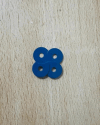Comparative evaluation of fluoride release profiles in new glass ionomer cements and conventional type II GIC: Implications for cariostatic efficacy
- PMID: 40230897
- PMCID: PMC11993395
- DOI: 10.6026/9732063002002009
Comparative evaluation of fluoride release profiles in new glass ionomer cements and conventional type II GIC: Implications for cariostatic efficacy
Abstract
The fluoride release characteristics of two new Glass Ionomer Cements (GICs), Equia Forte HT and Micron Bioactive, with a conventional Type II restorative GIC is of interest. Fluoride release, a crucial cariostatic property, was evaluated using 18 disc specimens prepared in disposable silicone molds and stored in deionized water for 15 days. Measurements taken on days 1, 3, 7 and 14 with a fluoride ion-specific electrode showed that Equia Forte HT exhibited the highest fluoride release, followed by Micron Bioactive and Type II GIC. Statistical analysis, including ANOVA, confirmed significant differences among the groups, highlighting the superior performance of Equia Forte HT. These findings emphasize the importance of selecting GICs with optimal fluoride release for effective dental restorations and call for further research into their long-term clinical performance.
Keywords: Equia forte ht; fluoride release; glass ionomer cement; micron bioactive; restorative dentistry.
© 2024 Biomedical Informatics.
Figures
Similar articles
-
Comparative evaluation of the physical properties of a reinforced glass ionomer dental restorative material.J Prosthet Dent. 2019 Aug;122(2):154-159. doi: 10.1016/j.prosdent.2019.03.012. Epub 2019 Jul 17. J Prosthet Dent. 2019. PMID: 31326149
-
Short-Term Fluoride Release from Ion- Releasing Dental Materials.Acta Stomatol Croat. 2023 Sep;57(3):229-237. doi: 10.15644/asc57/3/3. Acta Stomatol Croat. 2023. PMID: 37808411 Free PMC article.
-
Evaluation of mechanical, optical, and fluoride-releasing properties of a translucent bulk fill glass hybrid restorative dental material.J Esthet Restor Dent. 2024 Mar;36(3):503-510. doi: 10.1111/jerd.13168. Epub 2023 Nov 23. J Esthet Restor Dent. 2024. PMID: 37994681
-
Fluoride release and uptake by glass-ionomers and related materials and its clinical effect.Biomaterials. 1998 Mar;19(6):503-8. doi: 10.1016/s0142-9612(97)00130-0. Biomaterials. 1998. PMID: 9645556 Review.
-
Comparative Evaluation of the Remineralizing Effects and Surface Micro hardness of Glass Ionomer Cements Containing Bioactive Glass (S53P4):An in vitro Study.Int J Clin Pediatr Dent. 2010 May-Aug;3(2):69-77. doi: 10.5005/jp-journals-10005-1057. Epub 2010 Aug 17. Int J Clin Pediatr Dent. 2010. PMID: 27507915 Free PMC article. Review.
Cited by
-
Bioactivity of Glass Carbomer Versus Conventional GICs in Sound Enamel and Dentine: A 12-Month SEM-EDS Study.Materials (Basel). 2025 Jul 30;18(15):3580. doi: 10.3390/ma18153580. Materials (Basel). 2025. PMID: 40805458 Free PMC article.
References
-
- Bahsi E, et al. Nigerian journal of clinical practice. . 2019;22:961. - PubMed
-
- Kumari A, et al. IP Indian J Conserv Endod. . 2023;8:189. doi: 10.18231/j.ijce.2023.036. - DOI
-
- Marnani NS, Kazemian M. Nanochemistry Research. . 2024;9:55. doi: 10.22036/NCR.2024.01.07. - DOI
-
- Robertello FJ, et al. The Journal of prosthetic dentistry. . 1999;82:172. - PubMed
LinkOut - more resources
Full Text Sources
Miscellaneous




